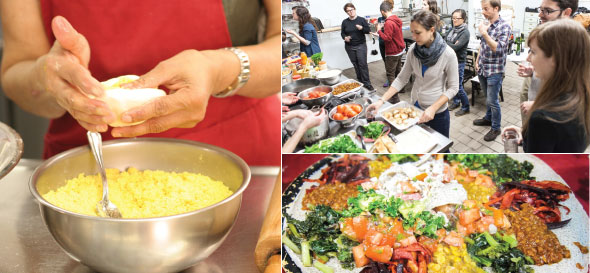alumni profile
Food Chain
A NEW FORUM HELPS NEW YORKERS PREPARE CUISINES FROM AROUND THE GLOBE
by Eileen Reynolds / GSAS ’11
As any kitchen novice who has attempted a favorite paella or paneer knows, it can be difficult to re-create the culinary delights served up in the restaurants of New York City’s ethnically diverse neighborhoods. But a trio of food- and travel-loving friends recently set out to change that by founding a forum for immigrant chefs to pass on their expertise to adventurous home cooks hankering for cuisine from Guyana to Egypt and far beyond.

Global Kitchen, which began as a project for a spring 2012 Foundations of Social Entrepreneurship course while Pete Freeman (WAG ’13) and Ryan Brown (WAG ’12) were students in the Robert F. Wagner Graduate School of Public Service, offers cooking classes led by food industry professionals who share authentic recipes and memories of their native countries. Each three-hour class begins with a demonstration and ends with the instructor and 12 to 15 students gathered around a common table to chat and enjoy the meal they’ve prepared together.
“Our social impact is derived from giving our instructors a platform to share their cuisine,” Brown says of the business, which was a finalist in the Leonard N. Stern School of Business’s Social Venture Competition. The two-man team later added Leah Selim (STEINHARDT ’13), who holds a master’s in food systems from the Steinhardt School of Culture, Education, and Human Development, as well as sommelier and author Alexis Herschkowitsch.
Since the launch of Global Kitchen, following a crowd-funding campaign that raised nearly $8,000 in the fall of 2012, each of the cooking courses has sold out—suggesting that New Yorkers are eager to learn the secrets to, say, Senegalese fish fatayas or Japanese daikon sunomono from cooks with decades of experience preparing these dishes.
Recent participants included couples who had just adopted children from Ethiopia and hoped to connect to their children’s homeland. “That was never something that we envisioned,” Brown says. “But we’re finding that people are coming to the classes for a lot of different reasons.”
There are unique benefits for the instructors, too, many of whom are referred to Global Kitchen by organizations—such as Harlem’s Hot Bread Kitchen—that offer support to immigrants starting food businesses. “They face certain barriers,” Freeman explains, “and one of our goals is to help them break [those] down.” This happens, in part, by using social media to market chef-instructors’ businesses and help them reach new customers. And by publishing on Global Kitchen’s website, cooks have an opportunity to preserve recipes that have been passed down orally for generations.
The next step, the owners say, will be to create a smartphone app that presents cooking lessons in miniature—each featuring, perhaps, a single recipe accompanied by a demonstration video and a story from the chef. Until then, here’s some food for thought:
CHICKEN YASSA (SENEGAL)
FROM CHEF NAFISSA CAMARA
INGREDIENTS
• 3 cups freshly squeezed
lime juice
• 8 large yellow onions,
thinly sliced
• 1 tablespoon freshly ground black peppercorns
• 1 teaspoon minced fresh habanero chile, or to taste
• 3 tablespoons soy sauce,
or 3 Maggi bouillon cubes
• 1 whole chicken (3 to 4 pounds), cut into 8–10 pieces
• 1/4 cup peanut oil or olive oil
• 1 tablespoon garlic powder
• 1/4 cup Dijon-style mustard, or American brown mustard
• 3 dried bay leaves
• 1 habanero chile, whole
• 1/2 cup pimento-stuffed or plain pitted olives (optional)
• Salt, to taste
• White rice, for serving
INSTRUCTIONS
Prepare marinade by mixing lime juice, onions, pepper, minced chile, and soy sauce. Place the chicken in the marinade. Cover with plastic wrap and allow chicken to marinate for at least four hours in the refrigerator. Preheat the broiler or oven to 450°F. Remove the chicken pieces and place in a shallow pan or on a baking sheet. Broil the chicken until browned on both sides (about five minutes per side). In a large sauté pan over high heat, combine oil, garlic powder, and mustard. Add chicken pieces and stir thoroughly. Add the marinade and bay leaves; lower the heat and cover the pan tightly. Cook slowly without stirring, until the onions are just tender and translucent. Add habanero chile and olives. Remove the chile after five minutes (or not, according to the level of heat you desire). Stir, then bring the mixture slowly to a boil, lower the heat, and simmer, covered, without stirring for 30 minutes, or until the chicken is cooked through. Season with salt. Serve over plain white rice.
For additional recipes, visit globalkitchenny.com.







